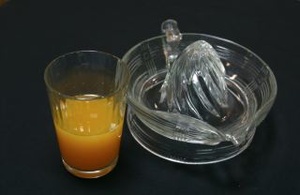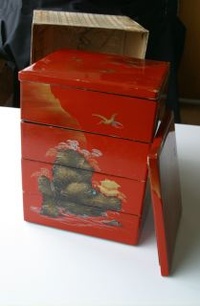“I can do better than that with one hand tied behind my back,” my father complained, checking out the liver and onions set before him. “Nanda konna meshi? You used the wrong hand.” Then, glancing at my mother’s stricken face, mumbled, “Maybe needs more bacon grease.”
“I’m sorry. I’m a bad cook. Tomorrow I’ll make takikomi. You like that.”
“Um. Fine.”
My mother didn’t have the luxury of conjuring up fancier dishes. Before the war she and my father labored, like most all Issei, from dawn to dusk. Meals were basic but healthy. Breakfast was usually orange juice (freshly squeezed on a glass juicer), oatmeal, or a boiled egg and toast, and a glass of milk. Sometimes she cooked shredded wheat into a hot cereal. Not bad. No one else I knew had ever heard of such a thing. My father preferred rice and fish in the morning, so he made his own.
It was a revelation to learn that my friends down the street—Sachiko, Helen, and Aiko—also dined on ochazuke in the morning and rice for dinner every night. “Good enough for us,” they said. The implication was that my mother was being uppity. Occasionally my father made a Sunday morning meal and we’d have French toast or pancakes with cinnamon drowned in a maple flavored sugar syrup. Yes, he was a better cook, but it may have been the rarity of the occasion that made it seem so, and the fact that he used sugar more liberally. My mother rationed it out. “Bad for the teeth,” she claimed.
My mother was concerned with our health and was convinced that an American diet was better. “Look, that’s why Hakujin are taller.” When my brother shot up to almost six feet, she proudly took a photo and sent it to her brothers in Japan claiming credit. They, in return, agreed that indeed the American diet was superior. They, too, had already begun to toast pan and boil eggs to accompany their rice and fish in the morning.
However, my mother did prepare a modest New Year’s spread each year: kamaboko, satsumaimo, sweet scrambled eggs, kuromame, shrimp, chicken, chestnuts, lotus roots, and, of course, ozoni with shungiku and mochi. We also had makizushi with broiled eel and kampyo. My father helped. I saw him deftly cutting small notches from carrot slices so they’d resemble flower petals. My mother busily mashed sweet potatoes and lima beans with a clawed masher. I was entrusted only to mix, carefully, the tiny dried sardines with soy sauce and sugar and the grated daikon with vinegar and sugar.
“We’re sure using a lot of sugar, Mom, how come?” I asked.
“Food tastes better,” my father replied.
“Food lasts longer so I don’t have to cook for a couple of days,” my mother explained.
“But, you said…” I started, but my mother cut me off.
“It’s New Year,” she said, and left it at that.
She unearthed the precious jubako and artistically arranged the pieces. “I brought this from Japan,” she told me. “Even in America I knew I must make special New Year’s meals.” I saw these red lacquer boxes only twice a year—New Year’s and at Japanese school undokai events.
I looked forward to the squares of mochi in the ozoni which were urged upon my brother and me as bringing good fortune. The more we ate, the longer we would live. Even as a child I knew that concept couldn’t be true. It just made one fatter. More fun were the dessert mochi toasted on an asbestos pad shaped like a ping pong paddle until they turned golden, then burst open. We savored them soaked in sugar and soy sauce or coated with kinako and sugar.
At first we gingerly picked—maybe with chopsticks, maybe with our fingers—one favorite piece from the array in the jubako and without ceremony, slipped it into our salivating mouths. I always aimed for the kuri kinton, the sweet golden chestnuts. Then a slice of kamaboko. My mother would admonish me for eating too many sweet items one after the other. After that it was a free-for-all as my mother, father, brother, and I dug into our Oshogatsu dinner.
Once or twice Mr. Tamaki, a family friend, joined us, and once my grandparents were there, but we never had crowds of relatives like so many Japanese families. Part of the reason for elaborate meals is a social reunion of friends and family and I wondered how many people our small kitchen table might seat if we invited more guests. That never happened. Much later in life I learned that these dishes were “osechi ryori.” We just called it “New Year’s meal.” Even my father had to admit that my mother used both hands for this feast. “Ah, oishii,” he’d say, and maybe down a shot of sake, warm and fragrant. He would give me a lick if I asked.
When we were incarcerated at Amache during the war those exotic meals came to an end. I remember mochi tsuki and bootleg sake, but no special Japanese dinner at year’s end. The day of the mochi tsuki was a major production. Someone had hollowed a shallow bowl in a log. Then with great gusto, two men pounded the rice with wooden mallets. When the glutenous paste was dumped on a mess hall table, a legion of women descended upon it and pinched off bits to roll into a ball. My friends and I snatched up one or two. The women gave us a little warning tap on the wrist but never restrained us. They giggled and chatted, too happy to take much notice of us.
“When we’re ‘outside’ again,” my mother said, “I’ll make a proper bowl of ozoni for us. Ima, shikataganai, let’s enjoy this.” We did just that.
Also at Amache I recall my introduction to soy sauced squid. I loved it, and despite the “Ug” and “Ohh” comments, helped myself to friends’ dishes when they claimed they’d gag on the little tentacles wriggling on their plates. I also discovered deep fried corn fritters dripping with fat. I think the cooks used bacon fat saved from the morning’s bacon. So delicious. We had no warnings of cholesterol back then.
When people complained about the infamous “Weenie Royale” again and again, I kept my mouth shut. Actually, they called it mostly “Weenie Junk.” Sometimes it was “Spam Royale, Spam Junk.” I loved those, too. Each camp had its version of this staple. Ours consisted of weenies, eggs, and onion served on white rice flavored, of course, with soy sauce. But the combination was not unique, for at home we used to have our own “original” version made of hamburger rather than frankfurters. It was infinitely versatile and could be magically changed with tomatoes or tomato sauce, curry, green peppers, and even leftovers.
Interestingly, breakfasts in camp were a continuation of my childhood fare with the additional inclusion of that ubiquitous bland cream of wheat which reminded me of glue. I noticed that even my mother avoided it. And sure enough, on Sundays, pancakes with maple flavored sugar syrup, sometimes with butter, but more often with the newly created “margarine” which was white, probably lard based. Someone salted it and colored it with packets of golden powder to create a yellow butter substitute. The pancakes were not quite as good as my father’s, though.
* * *
To supplement our diet my mother ordered Horlick’s malted milk and Ovaltine from Monkey Wards. They both had strange aftertastes but my brother and I drank them because they were “good for us.” The labels assured us that we’d have strong bones. No one understood about lactose intolerance in those years so I recall unexplainable squeezing gut pains and the runs after some meals. My mother told me it was due to eating too fast. “Chew your food thirty times before you swallow,” she’d say as I dashed for the bathroom.
The older kids were always harping about the quantity rather than the quality of the meals and they rushed off to other mess halls for another meal although Sumiya denied this. However, I remember he and his friends gossiping about checking out “the chicks” at various mess halls so perhaps ogling was the point, not food.
And the way we had to eat! Noisy pipe signals three times a day, rain or shine, snow or gale. Because those “bells” were also used for emergency call-ups, like volunteer fire squads, special meetings, and weather warnings, their sound was tinged with a sense of danger. Meal time rituals disintegrated. I sat with my friends, not my parents; my parents sat with their friends, Dad with his, Mom with hers. There was no “fun dinner talk” and the assault of so many people noisily jabbering disordered my mind.
The government decreed that the camps were to become self-sustaining, and thus funds could be diverted to “The War Effort.” I wasn’t sure what that meant, but I assumed the idea was that the money saved on trucking in foodstuffs would be spent on “military imposed priorities,” as Mrs. Bender explained. I think that meant tanks, machine guns, and fighter planes. We also heard that “outside” people resented that the evacuees were given rationed foods—sugar, coffee, lard, cheese, butter, canned milk, and jam in unlimited wasteful quantities, that it was unfair to the Patriotic Americans that the enemy—that was us—got treated so well. Perhaps the government was mollifying the public.
Because half the people in Amache arrived from rural areas, these farmers established themselves as leaders of this project, and the acreage south of Amache flourished and provided the camp with much of its vegetables, meat, and dairy products. By the following year, the cattle and pigs they raised were coveted by the surrounding towns and so calves and piglets were gifted to the townships around us. The farmers and workers seemed happy to be involved in labor appreciated by the people. I remember the rich aroma and taste of the first tomato from those fields. I let the juice dribble down my chin.
My mother said these farmers had “The Magic Touch.” She wistfully repeated “I wish I had that magic touch…such food.”
I corrected her, “It’s a ‘Green Thumb’.”
“Yes, but ‘Magic Touch’ is better.”
“‘Magic Touch’ it is,” I agreed.
* * *
I remember sandwiches and soup for lunch. We’d walk back to the mess hall at Block 9L at noon on school days and be greeted with either peanut butter and jelly on white, probably Wonder bread, or baloney with mayonnaise. Once when I asked the cook if there was something else, he snapped, “This isn’t a restaurant, kid. Maybe for a beppinsan over there we could fix up something,” and nodded toward a group of high school girls eating their lunch. The soup smelled of a mixture of whatever leftovers were found from the meals the day before and tasted equally nondescript. Sometimes the cooks threw in miso which seemed weird to me. Misoshiru was a morning broth, not mid-day.
“Don’t monku,” my mother said, “be grateful for what we have.”
We supplied our own after-school snack bought from the canteen: soda crackers with peanut butter and jam. It was a far cry from the glass of fresh orange juice and cookies waiting for us in Los Angeles, but it was enough to stop the grumbling of our bellies. Today I sometimes find myself fixing that same snack, crackers with peanut butter and jam, when hunger strikes at that suspended hour of three o’clock.
After our camp experience my mother continued with the New Year’s dinners, but each year they became plainer. My father had hurried off to different cities seeking the “perfect job,” so creating elaborate meals for the three of us seemed an extra burden. Then after my brother, still a teenager, left for a job in Alaska she wondered if I minded having only ozoni that year.
“As long as you promise it will have mochi,” I teased. I offered to take on part of the job, but she only said, “Too much trouble.”
Today, with a husband who prefers pizza to rice, I’ve continued the “only ozoni” tradition, but perhaps with the passing years even this may become “too much trouble.” Wistfully I wonder if someone will surprise me/us with a grand osechi spread one year. I could order in, but it’s not the same.
** Excerpt from book, "Gasa Gasa Girl Goes to Camp," to be published by the University of Utah Press.
© 2012 Lily Havey








